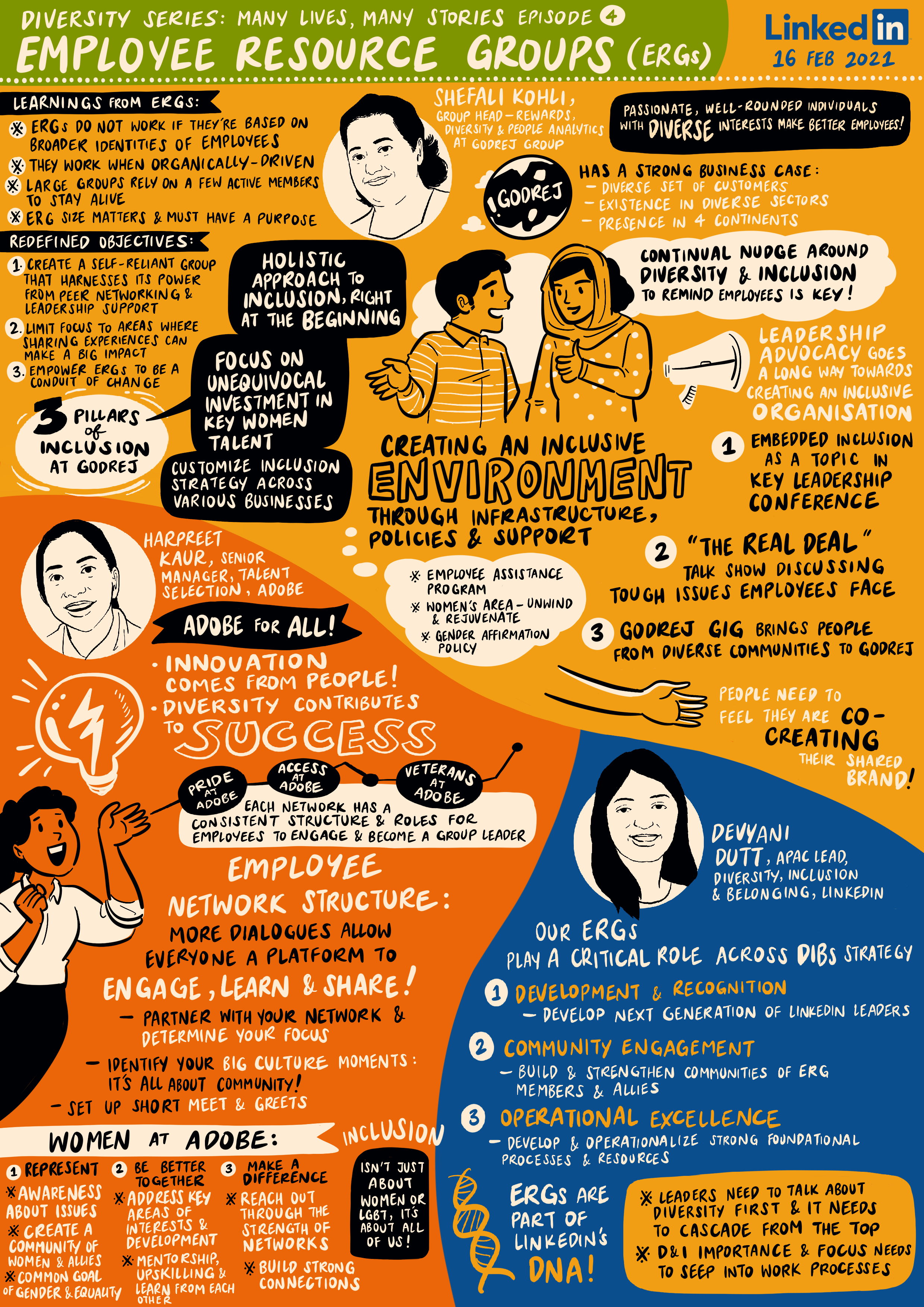Creating business value through Employee Resource Groups (ERGs)
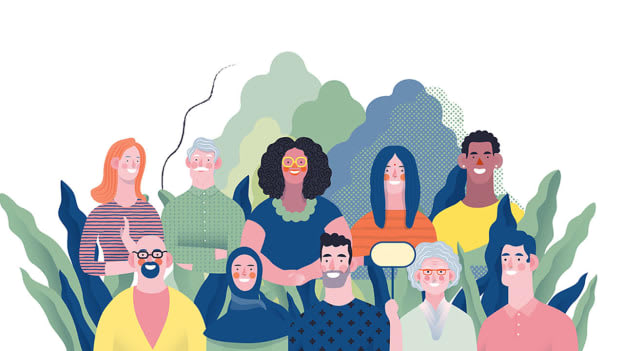
LinkedIn’s latest report on The Future of Recruiting: How COVID-19 is transforming recruiting, indicates an emerging prioritisation of diversity, inclusion and belonging across APAC. According to the report, “Diversity is no longer a compliance measure, or a tick-box exercise but an integral part of any organisation’s talent plan. But cultivating a culture of belonging, where people are empowered to express their ideas to unlock new solutions and innovation, doesn’t happen overnight — which is why we’re seeing a rise in the number of diversity, inclusion and belonging positions across Asia-Pacific.”
So how are employers elevating their inclusion practices to meet the evolving employee expectations? Sharing how Godrej and Adobe are working towards fostering inclusion at the workplace, in episode four of LinkedIn’s Diversity Series: Many Lives, Many Stories, industry leaders Shefali Kohli, Group Head - Rewards, Diversity and People Analytics, Godrej Group and Harpreet Kaur, Senior Manager – Talent Selection, Adobe, dove into enhancing business impact through ERGs, suggested structure and best practices to run ERGs effectively and described what pillars enabled the respective organizations to drive inclusion.
Read on for highlights from the session!
The pillars of inclusion at Godrej
Kickstarting the session with a business case for DNI, Shefali Kohli, Group Head - Rewards, Diversity and People Analytics, Godrej Group reflected on an interesting perspective, “We look at our sphere of customers like how many women are our customers, how many continents are we present in, where all is our international revenue coming from, what kind of diverse sectors are we existing in today. Now if all of this is diverse in its own being, then why would we not be embracing diversity across the organisation in all facets? Why would I not see the representation of my customers within the same pie within my employee base as well, because that's where the perspectives, the innovations, the thoughts, the ideas will emerge and strengthen our future flow of revenues as well.”
“For us, inclusion is a business imperative. As an organization we should champion the diversity we see in our consumers in order to innovate, evolve, and grow,” added Kohli.
Sharing Godrej’s diversity and inclusion philosophy, Kohli explained the three guiding pillars for the firm:
- Holistic approach to Inclusion
- Unequivocal investment in key women talent
- Tailor for Impact
In order to cater to a diverse composition of employees with their individual needs, Godrej has designed its offerings in a manner that caters to all diverse employee segments with initiatives including EAP services, flexi timings, adoption leaves extended to same sex couples, infrastructure audit for people with disabilities, and Employee Resource Groups (ERGs). Let’s explore how Godrej is working in this direction and amplifying the Inclusion agenda through ERGs.
Godrej’s approach to outpace bias and foster inclusion
At Godrej, leadership advocacy has been a game changer when it comes to fostering inclusion. The culture of inclusion in the organization is driven right from the top. Their annual leadership conferences intend to expose the leadership to different perspectives to enable them to be even more inclusive and drive change. Such conferences have helped us percolate the ethos and culture of inclusion to other employees as well.
Beyond working towards building leadership capabilities, Godrej has implemented a series of programs to enable and empower women. Here are a few:
- Caregiver policy: Supporting transition of new mothers back to work and allowing others to bring along a caregiver and infant for work-related travel
- Mandating minimum number of female candidates to be evaluated for first round of open senior leadership roles
- Safe stays for women employees: Hotel properties certified by Godrej keeping in mind women's safety parameters
- High gender diversity on boards of all group companies (35% gender diversity in GCPL) board
One of the key programs that the organisation drives to foster inclusion is creating employee resource groups, or ERGs as they are known, to build a psychologically safe space for employees to come together and share experiences and challenges, with the ultimate aim of building a sense of community and camaraderie. Like several organisational initiatives, ERGs come with their own set of challenges.
Sharing Godrej’s experience and learnings from setting up ERGs, Kohli said, “While we did experiment with the traditional format of ERGs, we soon realized that for ERGs to be successful they need to be rooted in our organizational realities and the format for ERGs needs to be customized accordingly.”
Redefining ERG objectives for efficiency
Upon launching ERGs or alliances for parents and women, over a period of time, Godrej realised that “Women don't want to necessarily align with all other women just because they are women, that doesn't bring them to feel a sense of shared purpose.” Similarly, when Godrej set up the LGBTQ+ ally network, it found that while camaraderie was brewing among people from the community and the small number of allies who joined in, there was not much impact on the larger community or even at the leadership level.
On analysing reasons for limited response and success, Godrej learnt that if the group is too large, while you'll end up having a few active participants, the rest of the people who are not able to connect with a particular topic which is being discussed at that juncture tend to slow down. The organisation noted a drop in activity across these groups gradually, and started to see exits over a period of time.

Explaining why inorganic push doesn’t work to draw participation in ERGs, Kohli said, “If I haven't built a shared purpose, if I haven't brought an optimal size together, then I cannot expect that an inorganic push on one individual trying to drive ERG will result in things meaningfully coming together. So it has to be a lot about the people, for the people kind of experience, where everyone is feeling like they are co-creating their agenda, co-creating their shared experiences, and therefore receiving something out of the effort and investment that they do to come together as a community.”
Diving into one of Godrej’s successful ERGs, Accel, a women leadership program, Kohli said, “Accel was envisioned as an intensive 15 months long learning intervention for high performing women employees with the aspect of peer learning woven very strongly into the program. Since all of them were similarly placed in terms of their current roles, career trajectories and personal lives, they found peer networking extremely beneficial.”
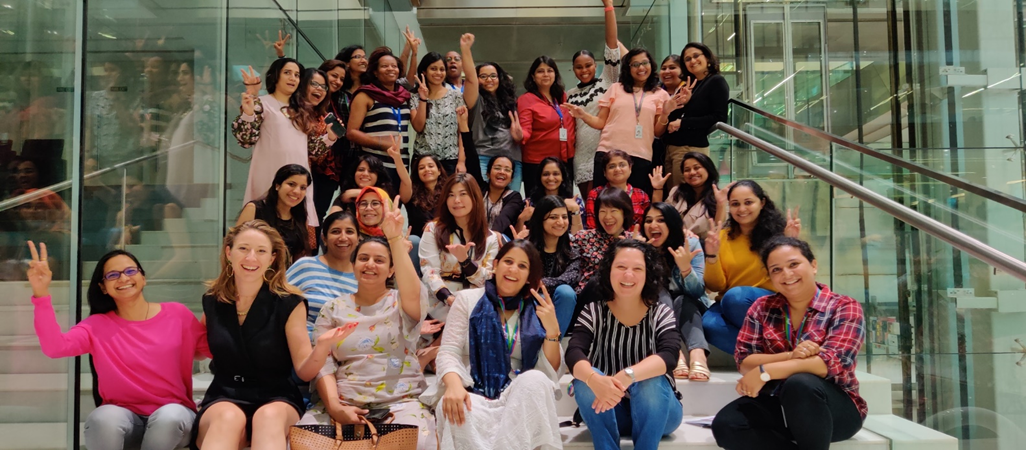
Emphasising a sense of give and take in ERGs, Kohli highlighted the need to recognise the importance of acknowledging the give in the equation, while everyone derives their own takes simultaneously. “What is something that this group is willing to give to the larger organisation, to the leadership, to the peer group, such that that helps us change and shift the needle in the larger audiences well.” She added, “While I'm receiving camaraderie, I'm receiving a perspective, I'm receiving a vent out in a certain environment, which is what is the take for me in that equation is, what am I giving to the larger ecosystem around me? So, rather than creating a microcosm, which is what we're calling the ERG, how does it then have the power to change and culturally shift the environment around us.”
ERGs are clearly a powerful tool for employers to not just build a shared purpose but provide a platform for employees to dive into shared experiences, fostering camaraderie and a sense of community that can relate to and understand your challenges.
While ERGs come with their own limitations, there are ways to eliminate the speed breakers and accelerate the inclusion journey.
Adobe’s approach to boosting impact of ERGs
In addition to her role as Senior Manager, Talent Selection at Adobe, Harpreet Kaur co-leads the Women at Adobe Employee Resource Group. With Adobe’s intent to keep it simple, here’s how the firm approaches the concept of ERGs: “We believe that when people feel appreciated and included, they can be more creative, innovative and successful.”
Stepping outside the linear approach to diversity and inclusion, Adobe recognised the need to work holistically work towards driving inclusion through four key pillars:
- Pipeline: Ensuring the talent funnel is representative of diverse groups
- Candidates: Making the interviewing and hiring experience inclusive
- Employees: Leveraging employee networks to foster a sense of community
- Industry: Partnering with organizations and learning from each other
Diving into the most critical pillar when it comes to ERGs - employees - Harpreet shares, “Employees is really where we use the power of ERGs. We look at employee networks as the forum where underrepresented groups find a way really to have more dialogues to feel that their voice has found a platform, a core group where they can engage, learn, share and possibly arrive at solutions as well.”
Tapping into the potential of ERGs, Adobe has 7 ERGs: Access at Adobe, Pride at Adobe, Women at Adobe, Veterans at Adobe, Black Employee Network (BEN), Asian/ Pacific Islander at Adobe, and Hispanic/ Latinx at Adobe. 4 of these ERG networks are active in India:
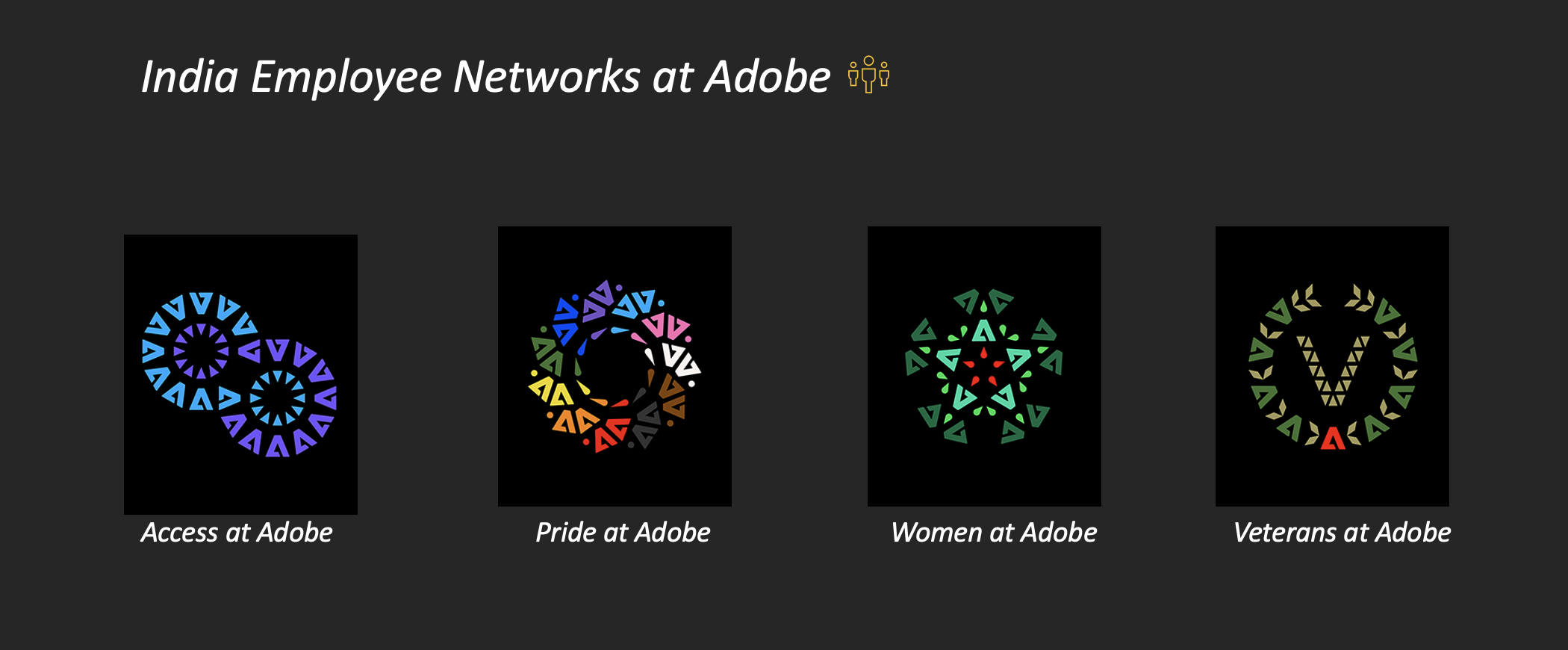
Highlighting that setting up an ERG is relatively easy, but running it is the difficult part, Harpreet spoke about Adobe’s approach to running ERGs, backed by individual roles catering to independent segments, to keep the ERG engine running. Beyond a robust ERG structure at Adobe, there are other best practices to keep the momentum going, shared Harpreet. Some of those include:
- Identify your focus areas, or “big culture moments” and create initiatives around it. Don’t try to solve everything at once. Identify those one or two focus areas for the year and plan with your network and site leads
- Encourage volunteer nominations who can provide feedback and contribute to shape what you want to focus on
- Setup short and regular meetings to stay connected
Advising ERG leads to not get discouraged by participation numbers, Harpreet recommended booming communication to ensure the message gets out, and gradually, “you will find those evangelists, you will find those catalysts in your group."
"Use their power, because this really is a power exercise and spreads from one to the other."
Weaving in efficiency and effectiveness in the Women at Adobe ERG, Harpreet highlighted the three pillars that shape the ERG and its strategies: Represent, be better together, make a difference. The network for women meets monthly to brainstorm ways the company can better support women:
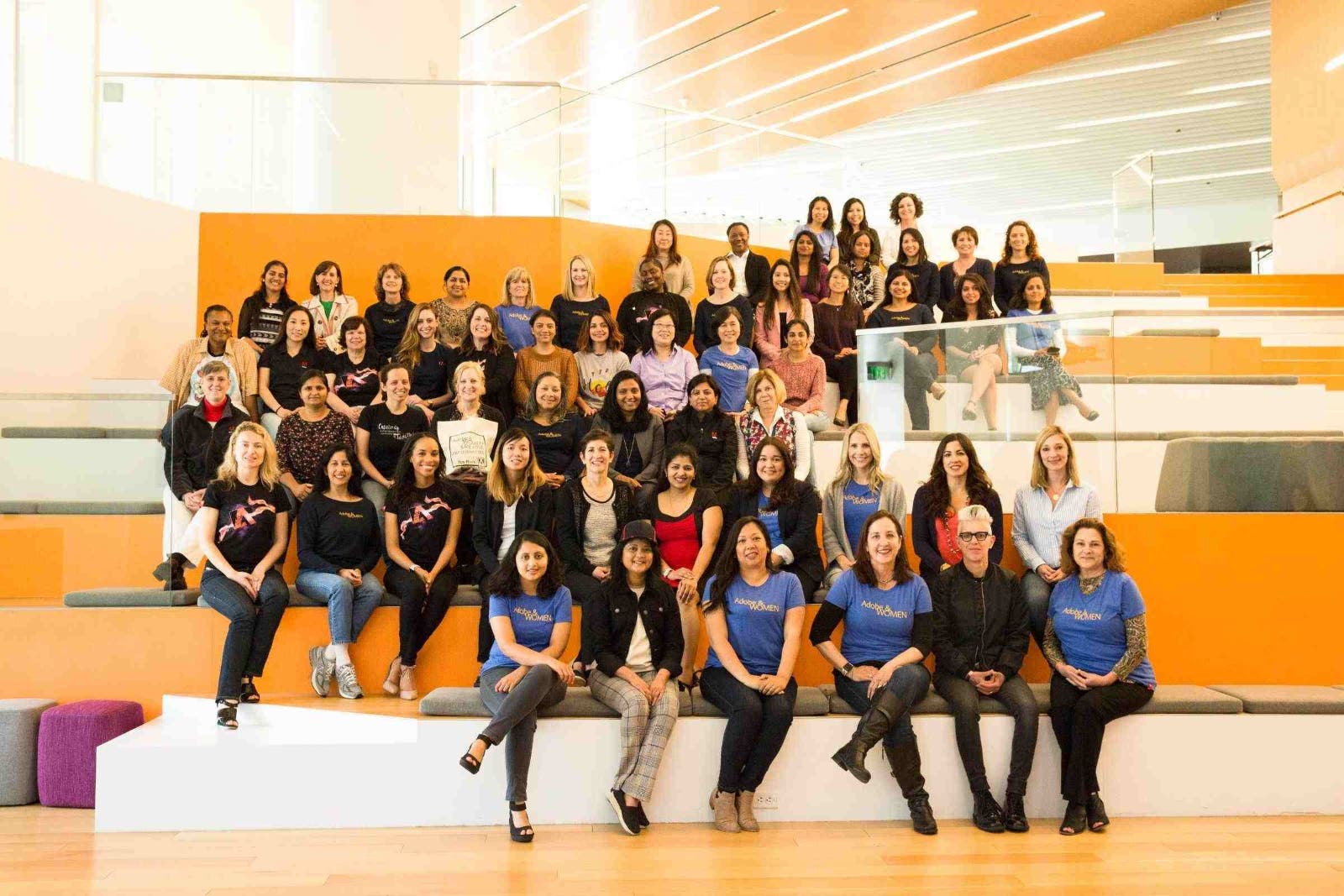
While one size might not fit all, the learnings from Godrej and Adobe sure help reflect and map where one stands in the journey, what to expect, what to be careful of and what to replicate without any further delay. After a rather turbulent year where many struggled to sustain businesses and jobs, in the road to recovery, DNI constitutes a critical piece as companies reset priorities and rewire the way work is done and culture is built.
In order to accelerate the journey of inclusion and belonging, the element of community plays a non-negotiable role.
By aligning their ERG strategy to the needs of the workforce, organisations have an opportunity to play a pivotal role in building a sense of community, trust and meaningful workplace relationships that consequently contribute to engaged employees, higher performance and better business results.
Here’s a quick peek into further discussion pointers from the LinkedIn episode:
